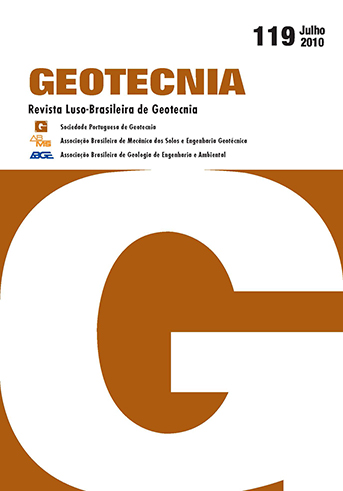Risk analysis of sliding using GIS
DOI:
https://doi.org/10.14195/2184-8394_119_4Keywords:
Risk, Sliding, Geographic Information System (GIS), Bayesian theoryAbstract
This paper presents a model for the Quantitative Risk Analysis, with the application of a Geographic Information System (GIS) using the Bayes theorem. It was adopted in the thematic integration of maps of the physical environment (vegetation, geological-geotechnical, natural drainage system and slopes). Based on this integration a sliding susceptibility map is created associated with vulnerability data (temporal and construction patterns of buildings) and risk criteria. This data is also used to create a quantitative risk map for a certain area. It can be stated that the use of an algorithm based on Bayesian statistics for thematic inte gration of maps of the physical environment provides reliable results in identifying areas susceptible to slide accidents. Lastly, the definition of risk areas is a valuable tool in slide risk management and, therefore, the data model developed in this study will be able to provide the public authorities with information for better planning of land use.
Downloads
References
Fell, R.; Hartford, D. (1997). Landslide Risk Management. Proceedings of the International Workshop on the Landslide Risk Assessment, Honolulu, Hawaii, USA, 19-21, February, pp. 51-109.
Fell, R. (1994). Landslide risk assessment and acceptable risk. Canadian Geotechnical Journal, Vol. 31, pp. 261-272.
INPE - Instituto Nacional de Pesquisas Espaciais, Spring. (2006). Básico.
www.dpi.inpe.br/spring/portugues/, set.
Lichtenstein, S.; Newman, J. R. (1967). Empirical scaling of common verbal phrases associated with numerical probabilities. Psychonometric Science, 9(10): 563-564.
Ministério das Cidades (2006). Capacitação em Mapeamento e Gerenciamento de Risco. Brasília, DF, Brasil, Cities Alliance.
Ministério das Cidades (2006). Prevenção de Riscos de Deslizamentos em Encostas-Guia para Elaboração de Políticas Municipais. Brasília, DF, Brasil, Cities Alliance.
Oliveira, L. C. D. ( 2004). Análise Quantitativa de Risco de Movimentos de Massa com Emprego de Estatística Bayesiana. Tese de D.Sc., COPPE/UFRJ, Rio de Janeiro, RJ, Brasil, 516 p.
Stutz, J.; Cheeseman, P. A. (1994). Short Exposition on Bayesian Interference and Probability. National Aeronautic and Space Administration Ames Research Centre: Computational Science Division, Data Learning Group, www.periodicos.capes.gov.br.
Varanda, E. (2006). Mapeamento Quantitativo de Risco de Escorregamentos para o 1º Distrito de Petrópolis/RJ utilizando Sistema de Informações Geográfica. Dissertação de Mestrado, COPPE/UFRJ, Rio de Janeiro, RJ, Brasil, 153 pp.
Vick, S. (1997). Dam Safety Risk Assessment: New Directions. “Water Power and Dam Construction”, June.




